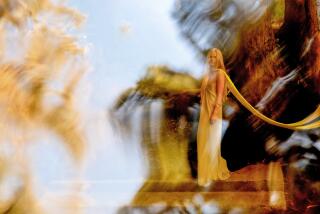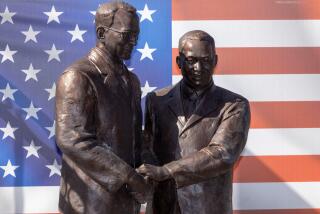March on Washington organizers look back
WASHINGTON — As they look back half a century later, five organizers of the March on Washington for Jobs and Freedom recall the thrill of the day — the sense that the cause of civil rights would advance.
Of course they remember the stirring “I Have a Dream” speech delivered by the Rev. Martin Luther King Jr. to the giant crowd gathered before the Lincoln Memorial. But they also recall the fear that the march might not come off, that people wouldn’t show up. Here are some of their recollections of that day, Aug. 28, 1963:
Clarence B. Jones
Clarence B. Jones remembers the “I Have a Dream” speech well — he was standing 50 feet behind King when he delivered it.
Jones was a lawyer, speechwriter and confidant of King and had helped draft the speech he was to deliver at the march. As Jones recalls, King was reading the prepared text when gospel great Mahalia Jackson shouted, “Tell them about the dream, Martin. Tell them about the dream.”
King set aside his script and began speaking extemporaneously.
“I turned to the person who was standing next me and said, ‘These people out there — they don’t know it, but they’re about ready to go to church,’” Jones said.
PHOTOS: March on Washington celebrations
Jones, who with Stuart Connelly wrote the book “Behind the Dream: The Making of the Speech that Transformed a Nation,” noted that King had spoken about his dream earlier, but those speeches had drawn scant attention. This speech, however, was carried live on television, and King, perhaps inspired by the huge audience in Washington and across the country, rose to the occasion.
“I had heard and seen Martin King speak many times before,” Jones said. “Never ever had I heard him speak like that. Nor did I ever hear him speak like that ever again.”
Jones, 82, is a visiting professor and diversity scholar at the University of San Francisco and a scholar at Stanford University’s Martin Luther King Jr. Research and Education Institute.
He plans to be in Washington for the 50th anniversary.
Reflecting on the speech 50 years later, Jones said, “When I hear people say, ‘Well, you know, much of the dream hasn’t been realized’ … that’s true. There are cracks in the dream. But I have to remind people there are no signs anywhere in this country that say, ‘Drinking fountains for colored only’ or ‘whites only.’”
Eleanor Holmes Norton
She had heard talk of plans for a giant march on Washington, but nothing had been nailed down and the question loomed: Could civil rights leaders pull it off?
Then, Eleanor Holmes Norton recalls, “I got the call, saying it is going to happen.”
Holmes Norton, then a 26-year-old Yale Law School student from Washington, D.C., had been working in Mississippi for the Student Nonviolent Coordinating Committee. “The call” was from the committee, asking her to come to New York to join the staff organizing the march.
PHOTOS: Looking back at the March
She went to work from the march’s Harlem office. She remembers the address: 130th Street and Lenox. She recalls the challenge: “The march was an unprecedented exercise. Nobody could remember a mass march on Washington for anything, certainly not civil rights.”
The day of the march, she boarded a plane to Washington, and before landing she could see the crowds assembling from the air — “enough to tell me the march would be successful.”
Later, she took in the view from the Lincoln Memorial. “What was most impressive for me, after working on the march for weeks, was looking out from the base of the Lincoln Memorial itself and noting that I could not see to the end of the crowd,” she said.
She recalls being moved deeply by one speaker after another. When it finally came time for King to speak, she thought to herself, “He had better be very good, because everything that went before him, I thought, was better than anything I had ever heard.’”
Holmes Norton, 76, went on to become the first female chair of the Equal Employment Opportunity Commission, an agency that, she notes, was a key demand of the march. She is in her 12th term as the District of Columbia’s nonvoting delegate in the House. She will be participating in the anniversary, including using the event to highlight another longtime cause: D.C.’s lack of voting power in Congress.
Norman Hill
On the day of the march, Norman Hill accompanied civil rights leader Bayard Rustin, one of the organizers of the event, on a visit to the National Mall, hours before the march was scheduled to begin.
Hill, then 30, was New York-based national program director for the Congress of Racial Equality. He became staff coordinator for the march, recruiting people to participate and raising money to help pay travel costs. But on that hot August morning, he and Rustin found the Mall still largely empty.
“I remember Bayard being surrounded by reporters who peppered him with questions. ‘Where are the people? Is the march really going to take place?’” Hill recalled.
DOCUMENTS: Coverage of the 1963 March
“Bayard reached into his pants pocket and pulled out a round watch, and inside his jacket pulled out a piece of paper, and looked back and forth at the watch and piece of paper and said, ‘Gentlemen, everything is going according to Hoyle, right on schedule,’” Hill added. “What the reporters didn’t know is that the piece of paper was blank.”
But in time the crowd grew — and grew and grew. When the march began, Hill recalls, the crowd was so eager to move that the march leaders had to rush to take their places at the front of the column.
He says that although the march is remembered as the largest civil rights demonstration in the nation’s history, it also was intended to call attention to economic issues, such as a massive federal jobs program.
He looks back upon the day as a seminal moment in the nonviolent civil rights movement.
“It did away with the stereotypes of blacks as troublemakers,” he said. “For me, the march was the fulfillment and implementation of the principles, vision and strategies of my mentors, A. Philip Randolph and Bayard Rustin. It solidified for me my faith in them and their place in American history as great, monumental figures.”
Hill is now president emeritus of the A. Philip Randolph Institute in Washington, named after the civil rights and labor leader and an organizer of the march.
Rachelle Horowitz
Rachelle Horowitz was the “bus lady.”
She was a 24-year-old civil rights activist from Brooklyn assigned to serve as transportation coordinator for the march.
It was a tougher job than people today can imagine in the high-tech age, she says. When she talks to students, she mentions her use of mimeograph machines, “and they go, ‘What?’”
“I say to kids, Dr. King gave that speech without Jumbotrons on the Mall,” she said, noting how difficult it was for the crowd way down the Mall to see the speakers at the Lincoln Memorial.
“By the end of the day, there was really this moment when you thought, by God, we can have a beloved community, that everything Dr. King and John Lewis talked about can come true,” she said.
But that hope, she noted, was dashed weeks later by the bombing at the Sixteenth Street Baptist Church in Birmingham, Ala. Four black girls were killed in the blast.
Horowitz went on to become political director for the American Federation of Teachers before retiring. She plans to be back on the National Mall for the 50th anniversary.
FULL COVERAGE: The March on Washington
Joyce Ladner
Joyce Ladner was a 19-year-old college senior from Mississippi with a stage pass to history.
Thanks to that pass, she was on the podium, and she remembers looking out at the crowd. She says it was “the most extraordinary thing” she had ever seen.
Before them, stretching into the distance, was a giant crowd that seemed to go on forever.
“I dare say that Martin Luther King and no one else on that podium had ever seen that many people together before,” Ladner said.
Ladner was a student at Tougaloo College in Mississippi and a field secretary for the Student Nonviolent Coordinating Committee when she went to New York to work on organizing the march. She talked at churches, synagogues and union halls in the New York area about the civil rights struggle in the South to raise money for the travel costs of those who wanted to attend the march.
“We were trying to build a national base of support,” she said.
On the day of the march, she first picketed the Justice Department to protest the arrest of three SNCC colleagues jailed in Georgia for sedition when they attempted to register voters. Then she headed over to the National Mall. She says it was still early in the morning, “and there weren’t many people there at all.”
She grew worried. “Are the people really going to show?” she wondered. Then about 8 a.m., busloads of people, mostly black but also white, began arriving with banners.
“And they just kept coming.”
She recalls standing with Josephine Baker, the black Parisian nightclub legend, and Hollywood stars, including Harry Belafonte, Marlon Brando, Sidney Poitier, Paul Newman, Joanne Woodward, Diahann Carroll and, she notes with a laugh, Charlton Heston, whose politics later veered to the right.
Ladner says that when reporters approached Lena Horne for an interview, the singer-actress “thrust [her] in front the camera and said, ‘Interview this young woman, because she lives in the Deep South. She can tell you the real story.’”
Looking back, Ladner says it’s disappointing that King’s “I Have a Dream” speech — and only part of it — is what most people remember about the day.
“I think it shortchanges him,” she said. And people, she said, “often quote the more optimistic parts of the speech. They don’t really talk about how to achieve his dream.” The march, after all, was for “jobs and freedom,” and yet black unemployment remains a serious problem.
Ladner, 69, who went on to become a prominent sociologist who served as interim president of Howard University in Washington, says that after the march, she knew the event would generate additional support for the civil rights movement.
“But we were going back into the same conditions,” she said. “The march would not have any effect on those Southern sheriffs and their deputies at all. That was our reality.”
A few weeks later, she was on a school bus headed to Birmingham for the funeral of the four black girls killed in the bombing of the Sixteenth Street Baptist Church.
Her stage pass has been displayed at the Mississippi State Archives but is being returned to her. “It is the one memento I have that I want to pass on to my son and grandson,” she said.
More to Read
Start your day right
Sign up for Essential California for news, features and recommendations from the L.A. Times and beyond in your inbox six days a week.
You may occasionally receive promotional content from the Los Angeles Times.







